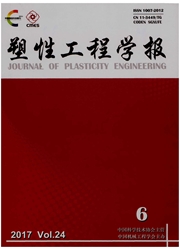

 中文摘要:
中文摘要:
三维Voronoi多面体由于和真实金属的细观结构相似,被用来模拟细观尺度下的微镦粗。该文分别建立了基于Voronoi图原理的光滑模型和粗糙模型,用来表示包含32、128晶粒的圆柱体坯料。光滑模型是Voronoi图的精确实现;粗糙模型则是通过对Voronoi图离散得到的,因此只是Voronoi的近似,但在计算开销方面有优势。对这两种模型建立的圆柱体坯料的微镦粗进行晶体塑性有限元模拟,并比较二者的结果。结果显示,在两种模型中,晶粒的增多减弱了塑性流动的各向异性,也增加了变形抗力。此外,光滑模型中,材料的塑性流动表现出更强的各向异性,其变形抗力要比粗糙模型得到的更小。
 英文摘要:
英文摘要:
The three-dimensional Voronoi polyhedron,which is topologically similar to the mesostructure of real metals,has been used to study microupsetting at the mesoscopic-level.The smooth model and coarse model based on the basic principle of Voronoi diagram were established respectively,and applied to represent the cylindrical billet containing 32,128 grains respectively.Smooth model is the exact realization of Voronoi diagram,while coarse model realized by discretizing Voronoi diagram is only an approximation of Voronoi diagram but has computational advantage.Finite element simulations of micro-upsetting within the framework of crystal plasticity theory were performed,and the results were compared in terms of heterogeneity of plastic flow and deformation resistance.The comparison shows that in both models,increasing the number of crystals tends to weaken the heterogeneity of plastic flow,and increase deformation resistance.Plastic flows calculated from smooth model are more heterogeneous than those calculated from coarse model,and deformation resistances calculated from smooth models are lower than those calculated from coarse models.
 同期刊论文项目
同期刊论文项目
 同项目期刊论文
同项目期刊论文
 Constitutive model for thin sheet metal with one or several grains across thickness in micro-forming
Constitutive model for thin sheet metal with one or several grains across thickness in micro-forming Blanking clearance and grain size effects on micro deformation behavior and fracture in micro-blanki
Blanking clearance and grain size effects on micro deformation behavior and fracture in micro-blanki Experimental investigation of distance effects between indenter and grain boundary on nanoindentatio
Experimental investigation of distance effects between indenter and grain boundary on nanoindentatio Effect of nano-crystals at surfaces induced by ion beam irradiation on the tribological behaviour in
Effect of nano-crystals at surfaces induced by ion beam irradiation on the tribological behaviour in A unified physically based crystal plasticity model for FCC metals over a wide range of temperatures
A unified physically based crystal plasticity model for FCC metals over a wide range of temperatures Mechanism of size effects in micro cylindrical compression of pure copper considering grain orientat
Mechanism of size effects in micro cylindrical compression of pure copper considering grain orientat Experimental research on micro-deep drawing processes of pure gold thin sheet using DLC-coated femal
Experimental research on micro-deep drawing processes of pure gold thin sheet using DLC-coated femal Crystal plasticity-based forming limit prediction for FCC materials under non-proportional strain-pa
Crystal plasticity-based forming limit prediction for FCC materials under non-proportional strain-pa An effective semi-implicit integration scheme for rate dependent crystal plasticity using explicit f
An effective semi-implicit integration scheme for rate dependent crystal plasticity using explicit f Optimal maintenance policy for degrading manufacturing systems using long-term average cost criterio
Optimal maintenance policy for degrading manufacturing systems using long-term average cost criterio Alleviating the computational load of the probabilistic algorithms for circles detection using the c
Alleviating the computational load of the probabilistic algorithms for circles detection using the c The Type Design of heavy-payload manipulators related to reducible performance between outputs and i
The Type Design of heavy-payload manipulators related to reducible performance between outputs and i Simulation of magnesium alloy AZ31 sheet during cylindrical cup drawing with rate independent crysta
Simulation of magnesium alloy AZ31 sheet during cylindrical cup drawing with rate independent crysta 期刊信息
期刊信息
